Nowadays, it can feel more difficult than ever to be productive. There are just too many distractions, particularly when it comes to technology — we have Instagram feeds to peruse, podcasts to listen to, and Netflix shows to binge, all typically right at our fingertips.
Technology has severely decreased our ability to focus. In fact, the average person's attention span has dropped from 12 seconds, in 2000, to a mere eight seconds today.
Eight seconds of focus before we become distracted — how is anyone supposed to get anything done?
Additionally, we can often feel so overwhelmed that we actually become less productive. For instance, a Cornerstone survey found 68% of U.S. full-time employees felt their productivity decreased when they had too much work and not enough hours in the day to complete it.
To help you combat task paralysis, we've compiled this guide with some of the best productivity techniques, apps, and tips to ensure you're able to check everything off your to-do list.
But first— what exactly is productivity?
Productivity Definition
Simply put, productivity is the effective use of time, energy, or resources in the production of goods or services. In this definition, the keyword is effective. A productive person can produce results quickly, or complete tasks, without forgoing quality.
It's important to note, productivity allows you to accomplish tasks in a reasonable amount of time. So productivity isn't just important for your work -- it's also vital for giving you extra free time to explore hobbies, passions, or connect with friends and family.
Now that we've covered that, let's explore some of the best productivity techniques you can employ.
Productivity Techniques
1. Pomodoro Technique
Boasting more than two million users, the Pomodoro Technique is a method developed by Francesco Cirillo that requires you to break your work into 25-minute intervals with short breaks in-between.
To implement the Pomodoro Technique, you need to choose a task and either manually set a timer, or use a chrome extension like Marinara: Pomodoro Assistant. Alternatively, if you're working off your phone, you might download an app such as the PomoDoneApp.
Once your time begins, get to work, and ensure you remain focused for those 25 minutes -- no checking Facebook or chatting with a coworker!
When the timer goes off, take a short three to five-minute break, and then start your timer again. Once you've completed four pomodoros (which will bring you to about two hours), take a 15 to 30-minute break to refresh.
Ultimately, the Pomodoro Technique is ideal if you feel you have a tough time focusing and have a schedule that is conducive to short intervals of work. The technique is meant to remind you of the value of your time. Rather than spending two hours "working" on an assignment (but taking regular social media breaks, lunch breaks, or socializing breaks), you dedicate 25 minutes to pure focus and use your five-minute reset time for those other distractions.
If you have a project due next week, this technique might be a good one to try out -- however, if you need to crank out a major work assignment due tomorrow, it's likely not as helpful.
2. Time Chunking
When we have an endless to-do list, it can be tempting to start checking things off at random, and often simultaneously. For instance, maybe you sit down and write the intro to your blog article, then you respond to some emails, then you call your friend about dinner plans later on, and then you move back to the article.
It can feel productive, but really, it's typically not the most effective use of your time.
Time chunking, on the other hand, is a technique that lets your brain settle in and focus on one task at a time for a long period before segueing to the next. Perhaps you block off 10 to noon as "content creation" time, and use that period to write— and only write. You don't check emails, or answer texts, or chat with coworkers.
Later, you can dedicate another chunk of time to another task. Additionally, you can clump similar tasks together— maybe you set aside 5 to 6 p.m. as your social media/texting break, and 6 to 8 as your exercise time.
Ultimately, time chunking enables you to eliminate distractions by choosing time periods and ensuring you only focus on one task during that time period. Plus, it removes the time you waste jumping back and forth between tasks. The less time you spend returning to your task after a momentary distraction, the better.
According to a study by Florida State University, productivity and performance are at their peak during uninterrupted 90-minute intervals— so, when in doubt, try chunking your time into 90-minute segments, and then move onto the next task after that.
3. Getting Things Done
Getting Things Done (GTD) is a technique invented by David Allen, author of Getting Things Done: The Art of Stress-Free Productivity. Ultimately, GTD urges you to get all your tasks out of your head and organized so they're easy to prioritize, manage, and complete. Additionally, GTD suggests you tackle your quickest tasks first, before completing more time-consuming projects.
At first, GTD can seem vague and difficult to adopt, but one of its benefits is its ability to be highly customizable. Simply put, GTD urges you to list out every task on your plate, and even write out mini-tasks within a larger task— so rather than writing "finish analytics report", you might write, "collect and export data into Excel, make graph, put into a spreadsheet, write notes to use during meeting".
Additionally, where you put this list is up to you -- you might write it on a notepad, use an app on your phone, or try a planner. Once you've created your initial list, organize it based on priority and due date, and then you can immediately begin tackling some of the most urgent low-hanging fruit.
4. Don't Break the Chain
Allegedly invented by famous American stand-up comedian and director Jerry Seinfeld, Don't Break the Chain is arguably the easiest productivity technique in this list. The idea is simple— come up with a major, overarching goal (like write a book, or learn how to play guitar), and put a big red "X" on your calendar for each day you accomplish a task required of your goal.
For instance, if you want to write a book, you'll put an X for each day you write at least another paragraph for your manuscript.
Ideally, this technique forces you to feel pressure to just sit down and do whatever it takes to accomplish part of your goal— if you don't, you'll break the "X" chain you've worked so hard to build. Additionally, it provides a visual representation of your productivity.
If you don't want to use a traditional calendar, you might try Don't Break the Chain!, an app with a virtual calendar on which you can place your X's, along with a list of your goals and an option to share your progress with others.
Now that we've explored some techniques you might implement to become more focused, let's dive into some apps you can use to further enhance your workplace performance.
Productivity Apps
1. Things
If you find yourself using Google Calendar to plan every aspect of your day — including "write blog post" and "take hot yoga class"— Things might be of use to you. The $9.99 app lets you separate your tasks into three neat sections: Today, This Evening, and Tomorrow. Additionally, the app lets you include Someday and Anytime tasks, so you can store all your random thoughts and goals in one place.
You can create to-do lists and checklists in Things, which helps you visualize what you need to get done immediately, versus what can wait until later. The simple interface makes it easy for you to efficiently organize your day and week.
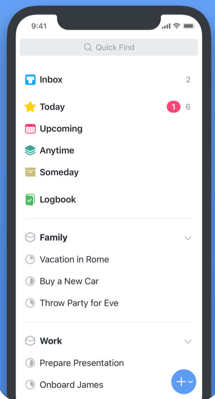
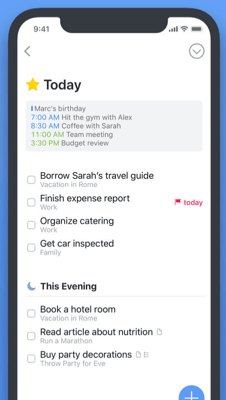
Source: iTunes App Store.
2. Focus
If you're interested in trying out the Pomodoro technique, Focus Sessions is a good app for you to check out. The app urges you to focus for 25 minutes, take a short break, and then resume. After four sessions, the app gives you a 15 to 20-minute break.
Additionally, Focus Sessions offers data on daily, weekly, and monthly activity so you can see how much you've completed, and how much you still need to do.
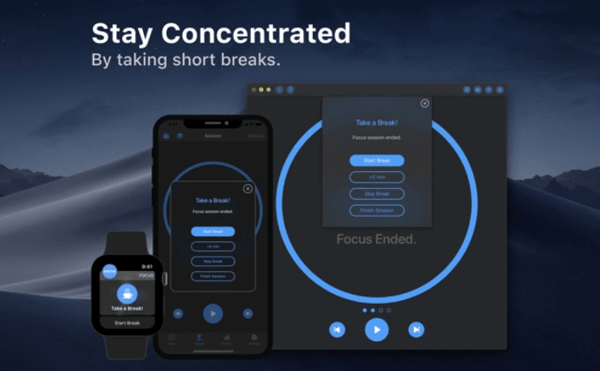
Source: iTunes App Store.
3. Todoist
Used by major corporations including Google, Apple, and Nike, Todoist helps millions keep track of their tasks and stay organized with minimal effort. To use it, simply type in a task or reminder, and Todoist's software will interpret and categorize your tasks for you. For instance, let's say you add "1 p.m. meeting with SEO team" to your list. Todoist will send you a calendar reminder of your upcoming meeting, and also categorize the task under "meetings".
The app's intuitive and easy-to-use functionality helps you visualize what you need to get done immediately, what you can delegate to others, and what can wait until a later time.
Additionally, your entire team can use the app to keep track of project deadlines, assign tasks to individuals, and discuss project details. It's free for basic functionality, $36 a year for premium features, and $60 a year for access for your entire team.
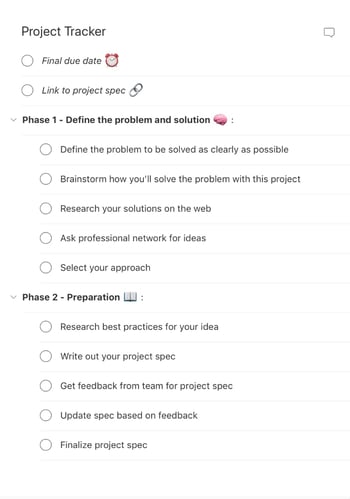 Source: Todoist
Source: Todoist
4. Forest
Whenever you want to focus and avoid distractions on your phone, you can use this app, which lets you plant a virtual tree and only kills the tree if you exit the app. As someone who's guilty of constantly answering texts, checking Instagram, or sending a Snapchat when I should be focusing on work, this is a fantastic app to ensure you stay on-track to complete your task.
Best of all, the app lets you earn virtual coins that are used to plant real trees with Forest's non-profit partner, Trees for the Future. A focus app and an opportunity to help the environment? I'd say that's a win, win.
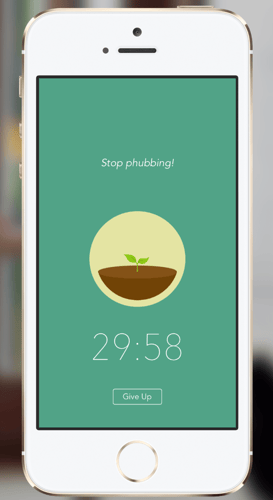
Source: Forest
5. Freedom
If you're someone who's perpetually distracted by certain websites or apps at work, it might be useful for you to check out Freedom, an app that blocks you from certain websites or apps during predetermined windows in your day.
The premise is simple— let's say you want to set aside 10 a.m. to noon to work on a presentation for your quarterly campaign. To avoid distractions, simply make a list of tempting websites and apps in your Freedom app (including social media sites, Gmail, or video game apps), and Freedom will ensure you can't access those sites or apps between 10 a.m. to noon.
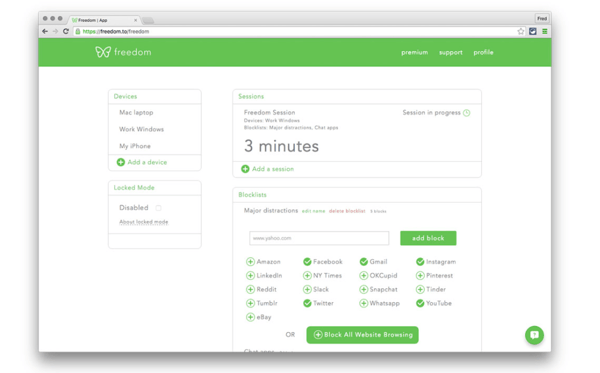
Source: Freedom
Productivity Tips
Finally, let's consider some habits or tricks you can employ in your day-to-day to ensure you're always optimally productive.
1. Exercise during the day.
We often compartmentalize exercise as a before-or-after work activity, but there are plenty of immediate benefits for increased daily productivity. For instance, a brief, 20-minute workout— like walking up and down the stairs at your office -- can allow you to think more clearly, and even decrease stress hormones, creating conditions for more sustainable long-term focus.
When you're under a tight deadline, you might feel like exercise can wait. But even a brief lunchtime walk can help you bang out that blog post with more energy and focus in the afternoon. Exercise can ultimately help you perform more efficiently, so it's critical you consider incorporating it into your workday.
2. Get enough sleep.
According to a study published in the journal Sleep, insomnia costs the U.S. workforce $63.2 billion per year in lost productivity. If you've ever sat down at your desk after a night of restless tossing and turning, you know -- sleep is a critical component for focus and mental clarity. Without getting enough sleep, you'll find yourself more easily distracted and more burnt out by even simple tasks.
Sleep can help us make better decisions, process memory, and solve problems. And, while the National Sleep Foundation recommends at least seven to nine hours, you know it varies for individuals. I personally need closer to nine hours to feel refreshed and focused, while I have colleagues who only need seven.
3. Prepare the night before.
To ensure you're able to leave work feeling fully prepared to start fresh and tackle your to-do list the next morning, you might want to leave yourself with a note of high-priority tasks you should focus on first. This will help you hit the ground running in the morning, and additionally, it can help mitigate any anxiety you feel at night about ensuring you remember what you need to get done tomorrow.
4. Maintain a healthy diet.
In one 2012 study, employees with unhealthy diets were 66 percent more likely to report losing focus. Ultimately, it's critical you view food and water as necessary fuel for long-term productivity — for instance, consider breaking up a healthy lunch into two parts, or eating small snacks in the afternoon like fruit or nuts to maintain a level of focus and clarity.
When you're busy, it can be tempting to scarf down a burrito and get back to work. However, it's important to remember a healthy diet can actually help you work better, for longer.
5. Take breaks.
While it might seem counter-productive, it's critical you maintain a schedule that allows for breaks to refresh and refocus your mind. If you struggle to look up from your screen throughout the day, you might even try to incorporate breaks into your schedule.
For instance, maybe you schedule a yoga class at lunch, a 20-minute meditation session in the afternoon, or a walk to a nearby coffee shop halfway through your morning. Ironically, getting away from your screen can help you focus better when you return.
Ultimately, it's critical you find a process that works best for you. Additionally, learn what time of day you function at peak efficiency levels, and ensure you save your most important work for that time. For instance, I've learned I work best in the morning, so I ensure I tackle my most challenging project as soon as I arrive at the office. Other people, however, likely need to take an hour to drink a cup of coffee and peruse emails before they're ready to hit their stride.
While there are plenty of tips and tricks in this article to get you started, it's imperative you learn how to customize your own schedule to suit your own productivity needs.
Ready for more productivity tips? Check out these technology products to help your team get stuff done next.
%20(1).png)
Better meetings start here
From huddle rooms to boardrooms and everything in between, we’ve got you covered with solutions that take teamwork to the next level.
Shop Solutions
